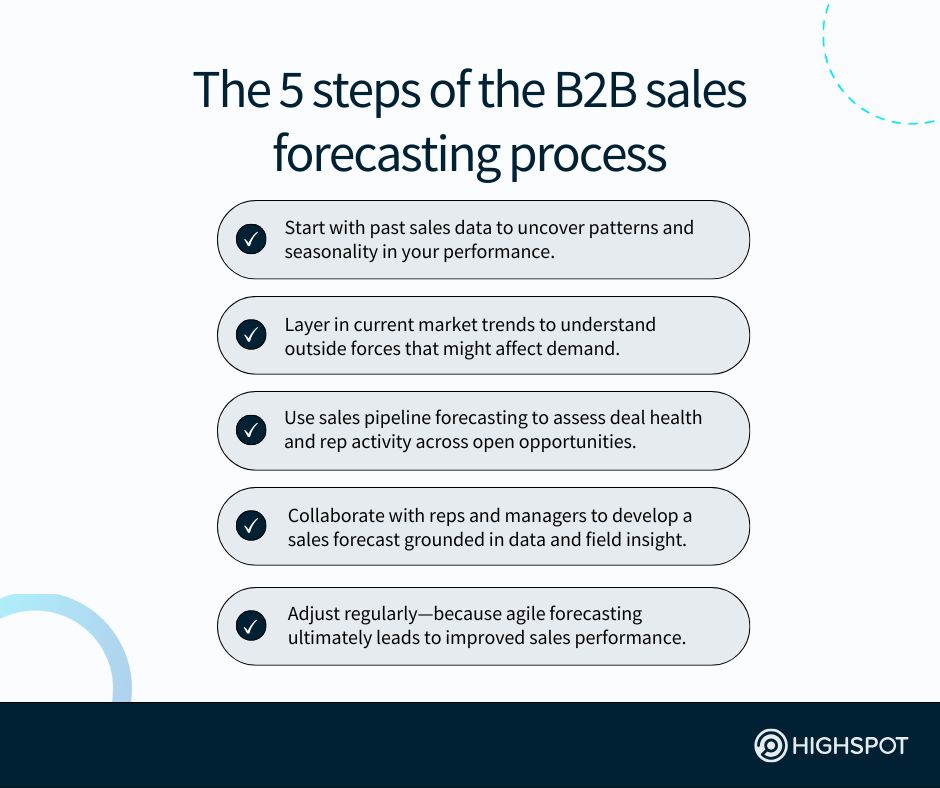Key Takeaways
- Sales forecasting gives your team the power to plan ahead, pivot fast, and stay in sync—turning messy, scattered data into crystal-clear insights that actually move the needle and drive results.
- Accurate sales forecasts are built from clean CRM data, historical trends, and real-time pipeline intel that help your whole go-to-market (GTM) crew make smarter, faster, and more confident decisions.
- From setting realistic targets to knowing where to double down, sales forecasting keeps everyone aligned, resourced, and ready to grow—so you can hit goals without the guesswork or scramble.
Sales forecasting is your crystal ball—minus the fog and fortune tellers.
It’s how smart go-to-market leaders like you more capably predict future sales and, in turn, future growth. And, if you’re serious about hitting your number, it’s the one thing key GTM stakeholders such as yourself can’t afford to guess on.
Simply put, sales forecasting gives revenue and sales leaders at large B2B companies an edge, allowing them to turn gut feeling into highly informed decisions.
But here’s the kicker: Forecasting isn’t just about looking ahead.
It’s also about looking back, too. You dig into past sales data, layer in market trends, account for competitors in your space, and use predictive analytics to spot what’s next.
The goal? Use documented sales processes and historical data to build a strategic sales plan you can trust—specifically, one that informs data-backed upgrades to your sales, enablement, and marketing efforts on an ongoing basis.
Modern B2B sales organizations aren’t leaving this to chance.
They’re building systems. They’re blending art and science. And they’re using sales forecasting not just to predict revenue, but to shape strategy.
Whether you’re prepping for a board meeting or just trying to stay one step ahead of others in your industry and vertical, there’s nothing better than seeing the future before it hits your pipeline so you can prepare your sales team to thrive.
What is sales forecasting?
Sales forecasting is the process of estimating future revenue based on a range of variables. What makes sales forecasting important is that it gives businesses the clarity they need to plan, grow, and adapt with confidence. Continual, accurate forecasting has proven to be a competitive differentiator for B2B companies.
The sales forecasting process entails analyzing past sales performance, evaluating current pipeline data, assessing the average sales cycle speed, and factoring in internal or external factors to help anticipate sales outcomes.
When done right, intuitive sales forecasting becomes a cornerstone of smart, data-driven decision-making that can improve resource allocation for sales teams and help GTM leaders better predict expected sales revenue.
The sales forecasting process, explained
Each organization has their own approach to generating predictive sales intelligence today, but there are certain tried-and-true sales forecasting methods that every B2B business can and should lean on.
At its core, forecasting is about predicting future sales based on your wealth of data and insights that reveal patterns in your pipeline. At a more granular level, though, it’s a bit more nuanced. Successful GTM leaders forecast sales by:
- Start with past sales data to uncover patterns and seasonality in your performance. Past performance is by no means an indicator of future sales trends. However, you can only make truly informed decisions tied to forecasting using enablement and CRM data (more on this shortly).
- Layer in current market trends to understand outside forces that might affect demand. External factors including macroeconomic conditions, new regulations (or deregulation), new entrants in your industry/vertical, and changing buyer behaviors and preferences impact sales forecasting.
- Use sales pipeline forecasting to assess deal health and rep activity across open opportunities. Ideally, your forecasting tools of choice make it easy to see where and why discussions with closed-lost prospects go off-rails and what contributes to closed-won deals so you can make data-driven sales process changes that scale what works for reps and ditch what doesn’t.
- Collaborate with reps and managers to develop a sales forecast grounded in data and field insight. Anecdotal ‘data’ should be taken with a grain of salt. That said, your sales professionals’ on-the-ground intel and hands-on experience can prove useful when forecasting sales.
- Adjust regularly—because agile forecasting ultimately leads to improved sales performance. Optimization never ends. You and other GTM leaders must regularly review sales data to ensure you produce consistently accurate sales forecasts your C-suite can trust completely.
Sales organizations at companies across industries rely on this rhythm to make smarter decisions. And while it’s never an exact science, this forecasting process framework can help you catch red flags early and plan your next move with confidence.

Why sales forecasting accuracy matters
If your sales forecasts feel off, your data probably is too.
Truth is, most forecasting misses the mark because the data lives in too many places—or worse, gets buried altogether. That’s where syncing your go-to-market enablement platform with your CRM to pull it all together becomes a game-changer.
You need the full story of what’s happening in your sales operations:
- What all your sales representatives are doing at every stage of the sales process
- Which content engages buyers in your sales pipeline and converts new business
- How buyers typically move through the sales cycle: from discovery to closed-won
- Where better plays or messaging or more timely outreach could’ve impacted deals
Some GTM enablement solutions, like Highspot, offer robust, real-time sales analytics that reveal what’s working and what’s not in every facet of your sales strategy.
Our direct integration with Salesforce also makes it easy for reps, managers, and go-to-market leaders alike to thoroughly (and quickly) examine historical business data and insights associated with recent deals. By doing so, they can each see what elements of the sales process help and hurt their revenue generation effor
With all your data in one place, patterns emerge. You can spot shifts in seller behavior, test hunches, and make more accurate sales predictions—all without having to manually refresh (and squint at) sales revenue spreadsheets.
More importantly, it gives you control—ensuring high sales forecast accuracy across teams, products, and quarters. Because when your data’s tight, your forecasts are too. And that’s how you go from guessing to growing.
“With the right sales enablement programs and processes in place, you can drive predictable revenue growth, increase operational efficiency, align to initiatives, and boost sales productivity to turn your highest-flying goals into something realistic,” Highspot’s Guide to GTM Alignment and Driving Revenue Growth explains.
3 essential benefits of sales forecasting
Odds are sales forecasting is deeply embedded in your go-to-market strategy.
Just in case you needed any more reason to analyze historical sales data and market trends to evolve your GTM efforts and ensure you set and hit lofty revenue targets, here are three key advantages forecasting affords your team.
1) Using accurate sales forecasts to inform sales targets
It goes without saying your sales targets should be more than a wish list. With the right forecasting software, you can turn scattered data into strategic insight that helps you achieve revenue operations KPIs.
Forecasting sales accurately means you’re not just hoping your sales reps hit quota—you’re giving them realistic, achievable targets backed by real-world patterns.
Using pipeline forecasting and sales cycle forecasting to understand lead quality and deal momentum helps leaders set goals that drive, not derail, performance.
Instead of overloading reps or underestimating the market, you get more precise sales projections that can ensure more intelligent and timely resource allocation related to your sales team and, in turn, better deal results across the board.
2) Predicting future sales performance and revenue growth
Estimating future sales isn’t magic for your revenue operations leaders.
It’s just math, timing, and trust in your data.
Good sales forecasts shed light on sales velocity and the likelihood of converting active opportunities in the days ahead. Great forecasts give you a line of sight into how your team will perform next month, next quarter, and even next year.
Executed well, historical forecasting combined with current deal signals can influence revenue outcomes and help you plan smarter. Because when you know what’s coming, you can focus on helping your team close, not just cope.
3) Making more informed decisions across GTM teams
Forecasting isn’t just for sales. When it’s shared across go-to-market teams, it becomes fuel for smarter sales enablement and product marketing efforts as well.
For example, predictive insights help marketers know which collateral and plays are being used by sales reps and resonating with prospects. What’s more, these insights give enablement the clarity to optimize what reps need to win more deals.
Leveraging forecasting tools and data makes knowing which sales process modifications to make ASAP a cinch. You stop guessing and start aligning. From how you engage leads, to how you support reps in the field, everything gets sharper.
TL;DR: Sales forecasting brings everyone in GTM to the same table—marketing, sales, operations, revenue, and beyond—all working toward the same business goals.
Sales forecasting methods for GTM teams
Achieving greater sales efficiency requires a coordinated effort by marketing, sales, enablement, and revenue teams. That said, how your organization defines efficiency will dictate the forecast analysis method you use.
Some of these most popular types of sales forecasting options include:
Sales trend analysis
This method examines historical sales data to identify long-term growth or decline patterns. It helps GTM teams see performance over time, pinpoint emerging trends, and make strategic adjustments. It’s especially useful for setting goals and evaluating whether current initiatives are improving or harming sales momentum.
Regression analysis
Regression analysis measures the relationship between sales and other variables, like marketing spend or territory coverage. It’s a data-driven way to isolate factors that impact performance and forecast outcomes based on those inputs. Use it to test assumptions and refine tactics across roles, territories, and regions.
Time series analysis
Time series analysis tracks sales performance over a consistent timeline: daily, monthly, or quarterly. It helps identify seasonality, recurring trends, and cyclical patterns that affect sales results. Utilize this method to adjust timing, anticipate surges or slumps, and build accurate forecasts around predictable fluctuations.
Moving average analysis
Moving average analysis smooths out short-term spikes and dips in sales data to reveal underlying performance trends. It averages sales results over a specific time window, giving GTM teams a clearer picture of deal velocity (or lack thereof). This is helpful for eliminating outliers and setting realistic benchmarks.
External factor analysis
This incorporates the previously mentioned outside influences into your forecasting model. It helps GTM teams like yours discern how external forces impact demand and pipeline health. Factoring in these elements leads to more realistic forecasts and helps explain performance beyond internal team activity.
The best sales forecasting software today
Building accurate sales forecasts doesn’t occur with one solution. It requires a host of leading platforms in your GTM tech stack that ‘speak’ with one another.
Here are some dependable sales tools you’ll find leading enterprise sales teams using to make highly informed decisions and forecast sales well into the future.
| Sales forecasting software type | Benefits of sales forecasting software | Examples of forecasting software |
|---|---|---|
| AI-powered sales enablement platform | – Tracks how training, content, and coaching activities directly impact forecasted deal outcomes – Connects rep readiness and buyer engagement data to pipeline velocity and revenue trends – Surfaces insights into what top reps are doing to drive forecastable pipeline growth across teams | Highspot |
| Customer relationship management systems | – Centralizes all sales activities, contact records, and pipeline stages to inform accurate forecasts – Provides deal stage visibility, helping managers project revenue based on pipeline movement – Enables rep-level forecasting by tracking opportunity health, close dates, and deal history | Salesforce, Microsoft Dynamics 365 |
| Sales pipeline management tools | – Identifies stalled or at-risk deals that could jeopardize forecast accuracy and revenue goals – Monitors opportunity progression, conversion rates, and time-in-stage to refine forecasts – Highlights historical deal patterns and benchmarks to predict close rates more precisely | Cognism, Close |
| Rep performance management solutions | – Aligns team quotas, territory plans, and compensation models with sales forecasts – Uses performance benchmarks and attainment data to model likely revenue outcomes – Predicts sales goal achievement using rep productivity and historical pipeline conversion rates | Everstage, CaptivateIQ |
| Configure, price, quote (CPQ) platforms | – Forecasts revenue impact by tracking quote volume, pricing strategies, and product mix – Surfaces trends in discounting, deal size, and quote velocity that affect future sales – Helps sales leaders project revenue based on most frequently configured products and services | Conga, DealHub |
| Revenue intelligence and orchestration tools | – Uses AI to analyze rep behavior, buyer engagement, and activity data for forecast accuracy – Flags forecast risk (missing targets) by identifying deals lacking recent engagement or next steps – Correlates revenue outcomes with real-time signals from calls, emails, and CRM activity | Gong, Salesloft |
| Business intelligence (BI) tools | – Builds dynamic forecasting dashboards by integrating CRM, ERP, and sales performance data – Tracks long-term trends, seasonality, and anomalies to refine prediction accuracy – Allows GTM teams to model best- and worst-case sales scenarios across segments and regions | Tableau, Microsoft Power BI |
| Marketing automation platforms | – Forecasts how current and future lead generation will contribute to pipeline and revenue – Connects campaign engagement to opportunity creation, enabling more accurate forecasts – Predicts which channels and lead sources will deliver high-converting SQLs over time | HubSpot, Marketo Engage |
Writing for MarTech, business expert Mark Stouse recently wrote that B2B GTM leaders “must adopt analytics and processes to enable better planning, forecasting, validation and optimization in response to evolving market conditions.”
That means allocating budget to the above tools—particularly AI-powered enablement software that helps all go-to-market teams conduct trend analysis into what enablement assets and approaches correlate strongly to revenue growth.
“Done correctly, a sales enablement strategy will increase sales quota attainment, cement the seller behaviors needed to drive growth, and help land marketing campaigns that increase conversion rates,” said Highspot CEO Robert Wahbe.
All that’s needed is a leading enablement platform at the center of your GTM tech environment that enables intuitive sales forecasting and sales strategy pivots.
Sales forecasting tool FAQs, answered
Need more info on how forecasting future sales pipeline growth and revenue can elevate your GTM performance? We’ve got answers to your FAQs below.
What are some of the most common sales forecasting challenges today?
Key challenges include inaccurate CRM data, inconsistent sales process execution, and rapid shifts in customer behavior. Sales teams also struggle with adapting to market volatility and aligning forecasts with current market conditions. These issues lead to poor visibility and missed targets.
Do I need historical sales data to accurately forecast sales projections?
Yes. Historical forecasting is essential for identifying patterns and setting realistic benchmarks. It provides a baseline for analyzing trends, refining the sales cycle, and anticipating future growth.
Which sales team performance data helps provide reliable forecasts?
Pipeline stage progression, win rates, and rep activity levels are foundational. Tracking sales quotas, deal velocity, and conversion metrics by sales representatives improves accuracy. Consistency in capturing and analyzing performance data is critical.
Should I use customer demand forecasting data to predict future sales?
Absolutely. Forecasting customer demand offers valuable insight into expected sales volume and timing. When aligned with market conditions, it enhances forecast precision and supports better planning.
How can I allocate resources effectively to act on sales forecast data?
Use forecast insights to align staffing, territory planning, and campaign spend with revenue potential. Match resources to projected sales capacity and adjust quickly in response to market volatility. Data-driven planning ensures optimal ROI and supports long-term future growth.




